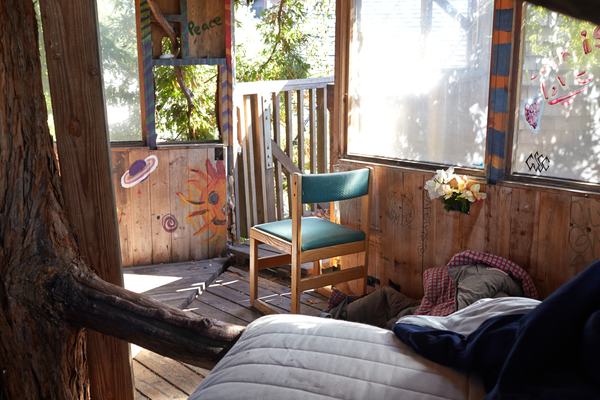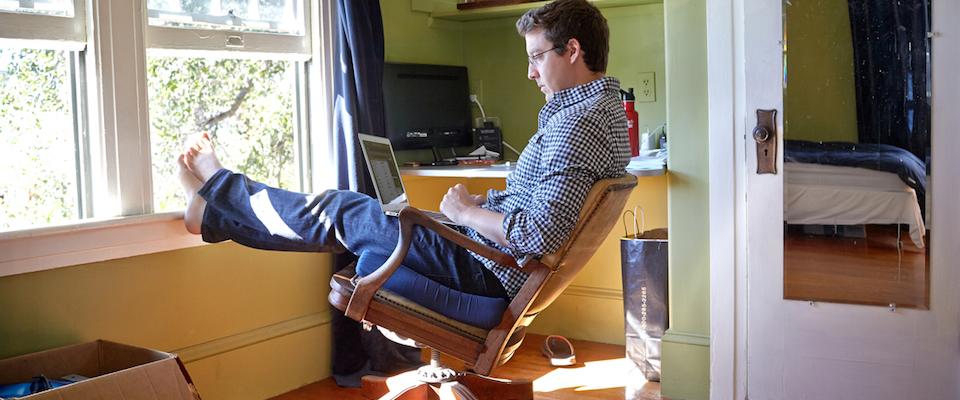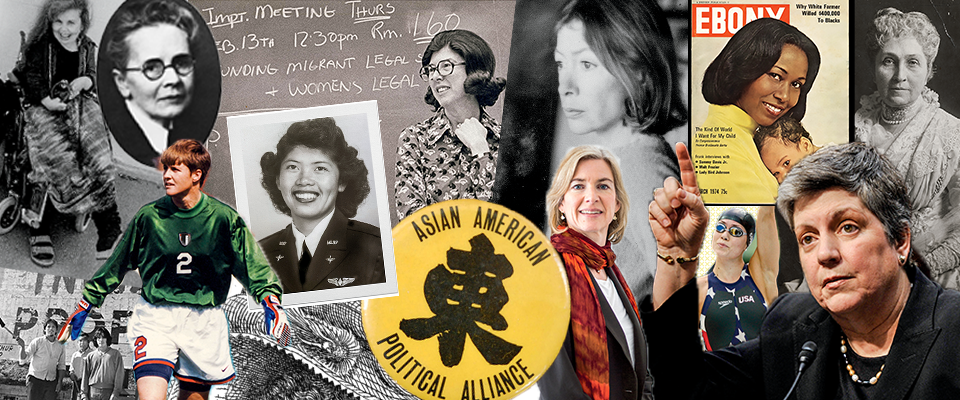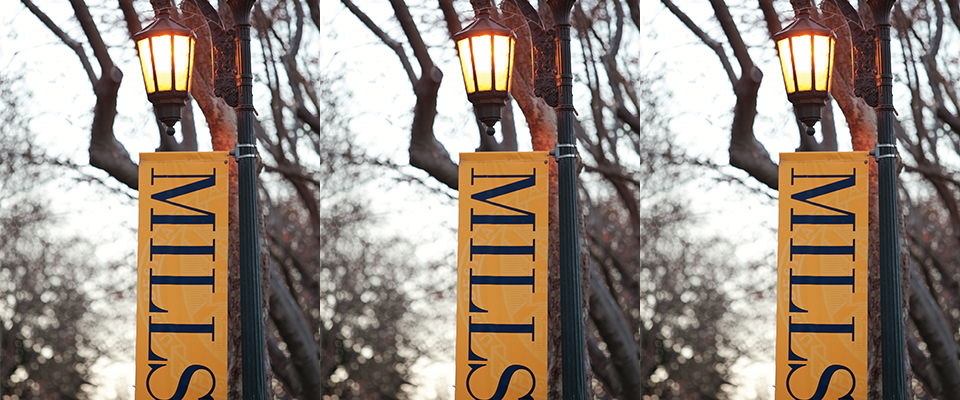The stereotypical student has long had a meager existence—subsisting on rice and pasta, living on the cheap in order to binge on swanky textbooks later. But for students in Berkeley, the most expensive U.S. college town according to Realtor.com, finding a place to live in a highly competitive rental market requires particular creativity. That means squeezing into packed apartments, or choosing less traditional approaches to survival: sleeping in their cars, docking illegally at the Berkeley marina, or renting out rooms through Airbnb.
One of a reported 1,162 Airbnb units in Berkeley is managed by radio producer Liza Veale, who’s been using the short-term rental company to rent out three rooms in her parent’s Elmwood home for the past three years. At first, she didn’t understand why so many students were renting out a room for roughly $1,000 a month. “It’s just a room in a house,” she said. “There’s no living room. There’s just a mini-fridge and a hot-water boiler. There’s no privacy, and you can’t have people over unless you pay more.”
Many of the students who stop by say it’s the cheapest option for a place so close to campus.
Take Michael Cangelose, a student in the weekend and evening MBA program at the Haas Business School. He’s planning to rent one of Liza’s rooms for the rest of the year. “Traditional rentals, close to campus, were really run down, or really, really expensive, like $2,000 a month,” he says. “Liza’s place had some compromises, but they were compromises I was willing to make at a price I was willing to pay.”
Maeva, a student studying Chinese who gave only her first name, still hasn’t found stable housing since she moved to Berkeley from France. She’s been moving roughly every week—sometimes twice a week—when her Airbnb rentals run out. “It’s kind of complicated to be in the process of looking for an apartment and have to think about school and everything,” she says. In her case, “It’s not a problem for me to pay. I have savings. It’s people not really trusting international students or people who’ve just relocated to the area.”
A former Berkeley student who asked to be named only as Oliver to avoid legal repercussions, lived in a tree fort with a co-op in Sonoma County before moving into the Lothlórien vegetarian co-op at Berkeley—except he didn’t technically live there. Instead of signing a contract, he paid a small fee of $150 to the Berkeley co-op account in order to live in on the rooftop, in what he describes as more of a shack than a tent.
“I would have been kicked out if the organization found out about it,” he says, adding that he wasn’t alone. He said that students like him, who pay a fee instead of signing a contract, are known as “fish.”

“I was one such fish,” he says. “Sometimes the way they do it is that they split the funds so instead of a single they have a double. I had a separate room built.”
Lothlórien is also known for the treehouse on its premises. Residents say if they know someone with an urgent need for housing, they will invite them to stay up there for a couple of weeks while they seek a more grounded long-term option.
Kim Benson, executive director of the Berkeley Student Cooperative, confirmed that there have been instances of co-op residents attempting to host long-term guests and sublet their space. While this practice is prohibited in the co-ops, Benson wrote in a statement, “We are cognizant of the fact that access to affordable housing in Berkeley and the greater Bay Area is quickly dwindling, and that this directly contributes to a marked increase in the sharing of living spaces and subletting throughout the community.”
Now, Oliver is a substitute teacher in Oakland and a researcher at the university. These days, he docks illegally in the Berkeley Marina, spending $300 on the docking fee and putting the rest towards boat maintenance. If he applied for live-aboard status, he’d be put on a wait list, and have to pay more. He said it’s not uncommon for Berkeley students to do the same to save money on rent.
“I live in standards that aren’t the standards of the First World. I have electricity, but not enough to run something like a microwave. That would blow out everything. I wouldn’t even consider having that,” he says. He doesn’t have running water or a sewage system. Some of his friends docking at the Marina illegally have been evicted; a spokesperson for the Berkeley Marina acknowledges that four to five people are evicted every month. But for now, Oliver likes the independence—and the fact that it allows him to afford to live in Berkeley.
But not everyone is so lucky. Some students who didn’t want to be identified say they’ve been living out of their cars or vans, showering with friends, getting used to awaking with stiff muscles, and trying to just hang in there. Others find the stress becomes overwhelming.
Lara Sedaghat says Cal’s reputation and her financial aid package drew her in, but when her freshman year ended and her guaranteed housing ran out, she ran up against Berkeley’s cutthroat rental market. “The cost of living is just disgusting,” she says. “Students are fighting to get housing.” She and two other students shared a one bedroom for $2,100 a month—she camped in the living room for $1,300 a month. Her financial aid wasn’t enough to pay for even half her rent. She took Spring and Fall semester off, and is still trying to figure out how to afford to return in 2016.
“It’s kind of like the strongest mentally are able to graduate,” Sedaghat says. “You have external stresses, like housing, and it becomes ten times harder to stay on top of your game. I have love for that school. I just wish they would realize that housing is a big problem for a lot of students.”

And then there are the commuters, like Brittney Griffin, a senior majoring in media studies and literature. She drives to campus from her $600 one-bedroom apartment in Walnut Creek, which she shares with her boyfriend. It’s a better deal than anything she could find in Berkeley and bigger. Still, the commute has its toll. “You’re spending all this energy sitting in your car,” she says. “It makes integration into the community difficult. You’re just going to school and then you’re going home. School is just some place that you go. It’s not a home to you.”
Tim De Guzman, a second-year microbiology major, had been commuting from Fairfield before he got a place at one of Berkeley’s co-ops. They have a long wait list and give priority to low-income and disabled students—and at roughly $3,000 per semester, they’re a bargain for students who do manage to snare a spot. De Guzman says that as a Filipino, he sometimes feels out of place in the mostly white Clough house: “You wouldn’t fit in if you weren’t wearing earth tones and drinking out of a mason jar and caring about growing your own vegetables and having a chicken in the backyard.”
This year Kate Feenstra, a literature student studying abroad from the United Kingdom, landed a deal at Cloyne Court, a substance-free, academic theme house. “The co-ops are really famous in terms of Berkeley,” Feenstra says. “I heard about them being really cool, but then I found out that the whole point of the co-op was that they’re low-budget. So because my student finance wouldn’t cover anything other than the co-ops, I wouldn’t be able to afford anything else.”
UC Berkeley researchers from the Urban Displacement Project recently released a study, with a handy map, detailing stages of gentrification in the Bay Area. Most of the analysis focuses on Oakland and San Francisco, but Berkeley is not off the hook. The map reveals that West Berkeley is already in the throes of gentrification, and parts of North Berkeley are at risk of gentrification, or already in the process of displacement
And then there are parts on the map near UC Berkeley, where students dwell. The researchers simply declared Southside and Northside “college town” and left it at that.

“We cut out the census tracts that were dominated by students because they have different mobility patterns,” says Karen Chapple, a founder of the Urban Displacement Project and professor of city and regional planning at UC Berkeley. “The kind of transition that we’re calling displacement means a different thing for them.”
But the transient nature of Berkeley students exacerbates Berkeley’s fierce rental market. “We’re seeing loss of low-income, long-term Berkeley residents as they get evicted to make way for students,” Chapple says. “There aren’t many hipster families that buy a house next to campus to raise a family there. It’s more students competing with themselves.”
Jay Kelekian of the Berkeley Rent Stabilization Board says students are more likely to pay more for worse living conditions than the average Berkeley resident. Plus, under the Costa-Hawkins Rental Housing Act of 1995, there is no limit to the rental rates at the beginning of a new tenancy. In a city with high turnover rates on apartments, such as Berkeley, landlords are permitted to raise rents often.
“It’s frustrating,” Kelekian says. “We didn’t have that problem prior to Costa-Hawkins. Before then, there wasn’t this incentive to push someone out.”
In Berkeley, students don’t need to be pushed out—they simply leave. “If everybody in Berkeley lived here forever, then we’d have rent that was significantly below the market,” says Christopher Palmer, assistant professor with the Haas Real Estate Group. “No landlord ever has to fight to keep a tenant because there’s always someone outside the door willing to move in.”
Students new to Berkeley are at a distinct disadvantage. Mark Tarses, who rents several properties in Berkeley, rarely has a tenant last longer than five years, and before he even needs to put an apartment on the market, he has tenants waiting to get in.
“The big losers are landlords who own rent-controlled apartments with tenants who will stay there until they die, and tenants who are coming into the market, but who will only be there for a few years, like college students,” Tarses said.
The median rent for a two-bedroom apartment was $1,850 a month in the last quarter of 2012, according to the Berkeley Rent Stabilization Board. A one-bedroom went for about $1,323.
The university’s cost of living estimates put an apartment at $7,184 for the 2015-16 term, but those estimates don’t account for how many students will be living in each apartment. The estimates are also based on how many students complete the Cost of Attendance Surveys—in 2012, that was 40 percent.
“The institutional leaders are blind to the housing needs of students because there is no way for students to let the university know in what conditions they’re living. One thing is to report on how much they’re spending on rent, and another is to report on conditions they’re in,” says Ruben E. Canedo, chair of UC Berkeley’s Food Security Committee.
And that’s a market that shows no signs of bursting. In 2012, 4,162 new students enrolled in Berkeley. By 2014, that number was at 5,466. In an email, university spokesperson Adam Ratliff wrote: “We understand that housing and living expenses are a very real concern for students and families. We did not have a rate increase for the 2015-16 school year. In comparative terms, our rate increase has averaged less than one percent annually over the last six years.” UC Berkeley has no plans to build more student housing, according to campus spokesperson Dan Mogulof.
And the squeeze affects UC Berkeley staff as well. “No one can afford to buy in Berkeley,” Chapple says. “The housing crisis is really having an impact on the quality of Berkeley faculty. And that changes campus life. This was always a place where people just kind of hung out 24/7. Now people just aren’t here. You can feel it in the halls.”





















